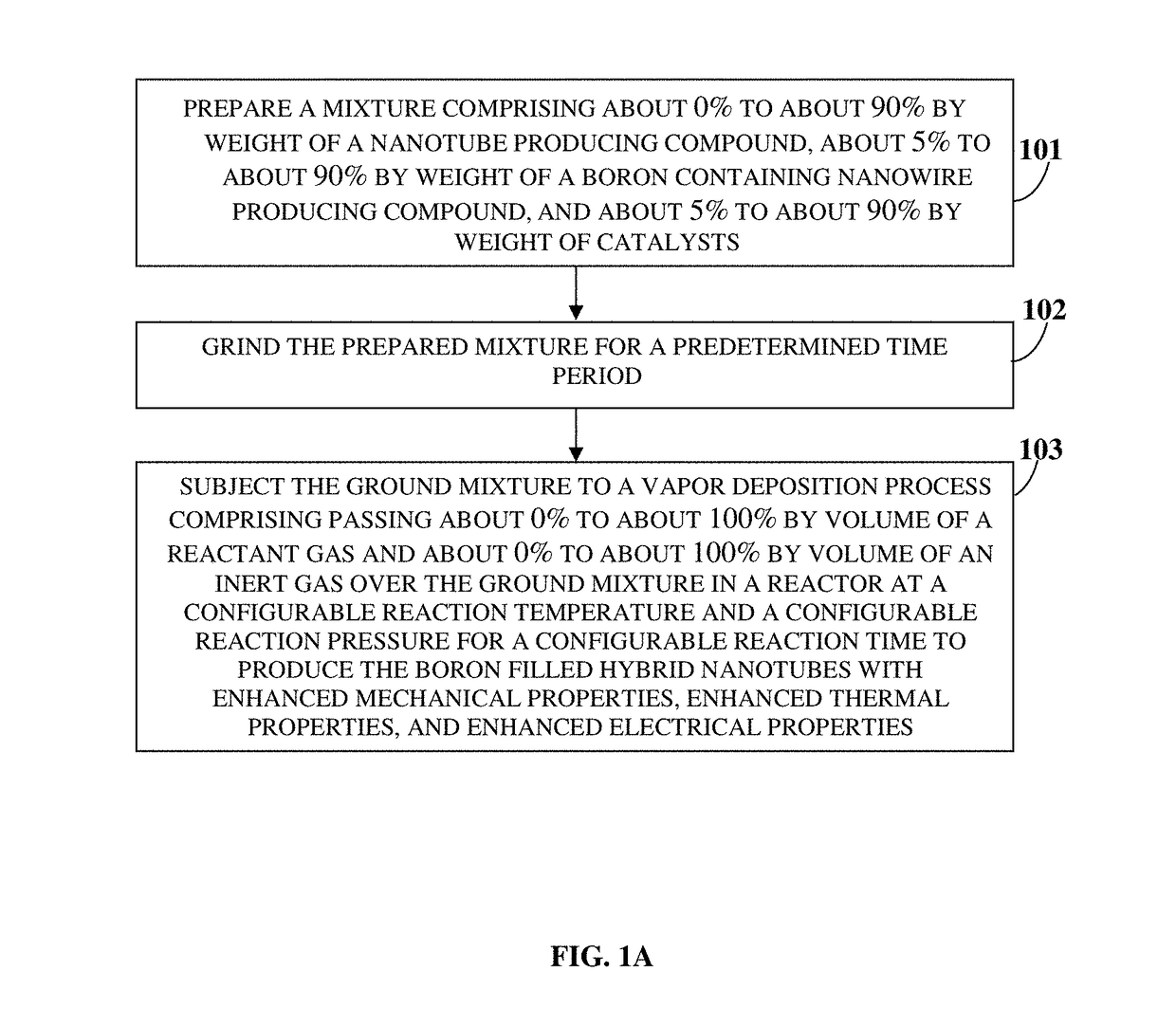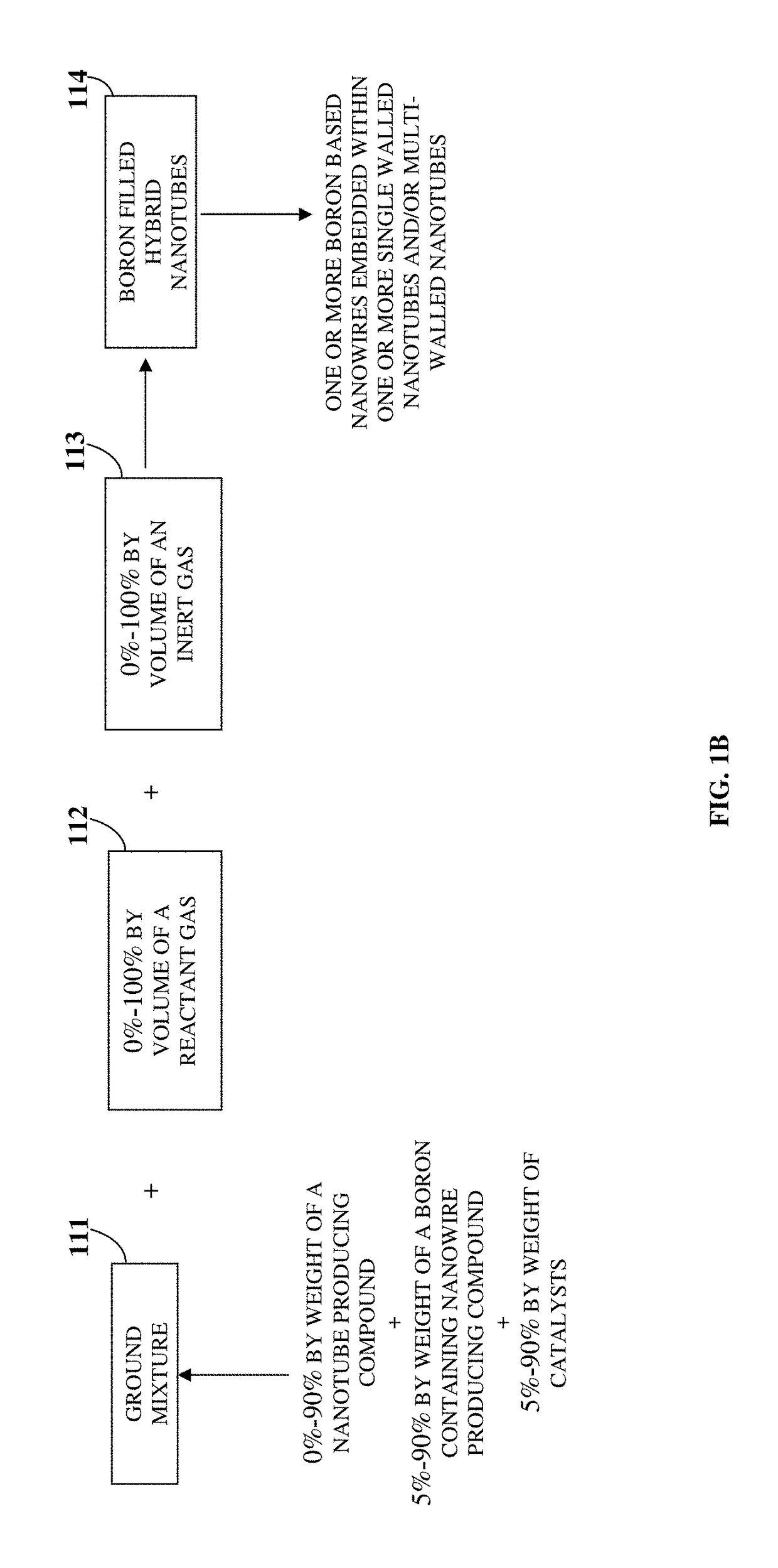Boron Filled Hybrid Nanotubes
a hybrid nanotube and boron filling technology, applied in the field of boron filling hybrid nanotubes, can solve the problems of carbon nanotubes that cannot perform well under compression, carbon nanotubes that cannot achieve the performance of composites, and general mechanical properties of carbon nanotubes are inadequa
- Summary
- Abstract
- Description
- Claims
- Application Information
AI Technical Summary
Benefits of technology
Problems solved by technology
Method used
Image
Examples
example 1
[0081]Consider an example where about 50% by weight of magnesium diboride (MgB2) and about 30% by weight of nickel boride (NiB) are mixed and ground for about an hour in an agate mortar and a rotary mixer. Magnesium diboride is the boron containing nanowire producing compound and nickel boride is the catalyst for the chemical vapor deposition process. In this example, about 20% by weight of a substrate material such as porous silicon is added to the ground mixture. A chemical vapor deposition process is then performed on the ground mixture by subjecting the ground mixture to about 90.9% by volume of an inert gas such as argon and about 9.1% by volume of a carbon containing reactant gas such as methane in a quartz reactor at a reaction temperature of 950° C. at a rate of 10° C. / min and at a reaction pressure of 1000 torr for about an hour to produce boron filled hybrid carbon nanotubes. In this example, the carbon based nanotubes are produced from the reactant gas, that is, methane, ...
example 2
[0083]Consider an example where about 90% by weight of magnesium borohydride Mg(BH4)2, a boron containing nanowire producing compound, and about 5% by weight of a catalyst such as iron boride are mixed and ground for about an hour in an agate mortar and a rotary mixer. In this example, about 5% by weight of a substrate material such as porous silicon is added to the ground mixture. A chemical vapor deposition process is then performed on the ground mixture by subjecting the ground mixture to about 90% by volume of an inert gas such as xenon and about 10% by volume of a carbon containing reactant gas such as acetylene in a quartz reactor at a reaction temperature of 950° C. at a rate of 10° C. / min and at a reaction pressure of 1000 torr for about an hour to produce boron filled hybrid carbon nanotubes. The nanotube producing reactant gas is the carbon containing reactant gas in this example. The boron filled hybrid carbon nanotubes are subsequently purified using, for example, about ...
example 3
[0084]Consider an example where about 45% by weight of magnesium borohydride Mg(BH4)2, about 45% by weight of boron carbon nitride, and about 5% by weight of a catalyst such as iron boride are mixed and ground for about an hour in an agate mortar and a rotary mixer. Magnesium borohydride Mg(BH4)2 is the boron containing nanowire producing compound and boron carbon nitride is the nanotube producing compound. In this example, about 5% by weight of a substrate material such as porous silicon is added to the ground mixture. A physical vapor deposition process is then performed on the ground mixture by subjecting the ground mixture to about 100% by volume of an inert gas such as xenon in a quartz reactor at a reaction temperature of 950° C. at a rate of 10° C. / min and at a reaction pressure of 1000 torr for about an hour to produce boron filled hybrid carbon nanotubes. The boron filled hybrid carbon nanotubes are subsequently purified using, for example, about 50% by weight of an acid su...
PUM
| Property | Measurement | Unit |
|---|---|---|
| Temperature | aaaaa | aaaaa |
| Temperature | aaaaa | aaaaa |
| Fraction | aaaaa | aaaaa |
Abstract
Description
Claims
Application Information
 Login to View More
Login to View More - R&D
- Intellectual Property
- Life Sciences
- Materials
- Tech Scout
- Unparalleled Data Quality
- Higher Quality Content
- 60% Fewer Hallucinations
Browse by: Latest US Patents, China's latest patents, Technical Efficacy Thesaurus, Application Domain, Technology Topic, Popular Technical Reports.
© 2025 PatSnap. All rights reserved.Legal|Privacy policy|Modern Slavery Act Transparency Statement|Sitemap|About US| Contact US: help@patsnap.com



